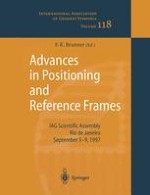1998 | Book
Advances in Positioning and Reference Frames
IAG Scientific Assembly Rio de Janeiro, Brazil, September 3–9, 1997
Editor: Professor Dr. Fritz K. Brunner
Publisher: Springer Berlin Heidelberg
Book Series : International Association of Geodesy Symposia
Included in: Professional Book Archive
